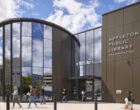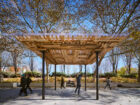SOM has unveiled its design for the development and expansion of N’Djili International Airport in Kinshasa, reimagining the Democratic Republic of the Congo (DRC)’s primary aviation gateway. The masterplan includes a full replacement of existing terminal operations, along with new infrastructure and facilities—including a new runway—to support both international and domestic growth.
As the country’s central hub for international air travel, the new terminal represents a transformative step in positioning Kinshasa as a modern, efficient, and globally connected city. Designed to be modular and scalable, the new terminal will accommodate up to 5 million passengers annually by 2037, with long-term capacity expandable to 9.1 million by horizon year 2050. This forward-looking development is key to advancing the DRC’s global economic integration, improving regional connectivity, and supporting the continued growth of local carriers such as Air Congo, the nation’s flagship carrier. The new terminal will offer travelers an immersive experience that seamlessly blends local art and culture.
Commissioned by Congolese developer Infrarose, part of a wider group which holds over 60 years experience in the country, the project is scheduled to break ground in 2025, with completion anticipated by 2028.
Said SOM Design Partner Kent Jackson, “Our plans for N’Djili International Airport go far beyond infrastructure, they’re a bold expression of the DRC’s national aspirations. Rooted in the country’s landscape and cultural heritage, the terminal design blends high-performance architecture with textures and patterns drawn from Congolese landscapes and traditions to create an international gateway that is both inspiring and efficient.”
“With decades of experience designing some of the world’s most complex and celebrated airports, we’ve brought the full breadth of SOM’s global aviation expertise to N’Djili,” said Derek Moore, SOM Principal. “By balancing cultural identity, operational efficiency, and future-ready design, the new terminal will serve as a modern, sustainable gateway for the DRC and Central Africa.”
Sanjeev Guness, CEO of Infrarose commented: “The development of the airport will bring about a transformational change to the image of DRC leaving a lasting impression and immersive journey to passengers. Together with our world-class strategic partners, we are building a fully compliant state of the art airport for the future and will leave a legacy for generations to come.”
SOM’s design is inspired by the DRC’s natural environment and cultural heritage. A rich, mineral-inspired material palette—evoking native earths and stone—grounds the building in its setting. The terminal’s most iconic architectural feature is its roof, a sweeping canopy inspired by traditional Congolese basketry.
Formed of square modular hyperbolic paraboloids (hypars) arranged in a grid, the roof creates a rippling surface that will filter daylight and intuitively guide passengers through the space. The structure not only forms a dramatic architectural statement, but also minimizes material use, enables straightforward construction, and supports future expansion.
Targeting LEED Gold certification, the terminal will incorporate sustainable materials, climate-responsive design strategies, and low-embodied-carbon systems. SOM has developed a sustainability framework tailored to the airport’s long-term environmental, economic, and social goals—aligned with the United Nations Sustainable Development Goals and the DRC’s national priorities.




